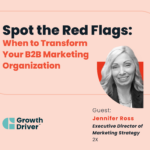A Deep Dive for B2B Revenue Leaders
The Growth Framework™ is a proven method that B2B growth professionals use to plan and execute efficient, aligned revenue growth. It lays out all of the key components and critical interrelated components of an effective, modern growth engine.
In this blog series, we’ll use The Growth Framework™ to identify pipeline problems and best-fit solutions, helping them build efficient growth. Riddled with complex challenges that demand robust, strategic approaches, efficient growth is not always simple to achieve. But when its momentum can be harnessed, efficient growth transforms companies into market leaders.
Use this five-layered strategy as a roadmap to not just identify pipeline problems, but to solve them from the root and harness truly efficient growth.
Layer 1
The Power of Clarity: Defining Growth Goals, Priorities, and Constraints
The framework begins with a candid assessment of your growth goals and priorities. What do your objectives look like? Are they defined in detail, accessible by all, and, most importantly, do they reflect your corporate strategy and market trends? This step requires more than just a vision board. Your growth goals must combine cross-functional efforts with a singular purpose.
Are Your Growth Goals Crystal Clear and Shared?
You’d be surprised how often go-to-market teams are not on the same page about what’s most important. It’s critical for the entire growth team to understand what success looks like when it comes to pipeline, critical KPIs, and the limitations that exist.
Without that clarity and consensus, your marketing efforts could be disjointed or simply ineffective. This cross-functional alignment is non-negotiable for cohesive growth.
Reality Check with Real-World Constraints
Unrealistic goals can often do more damage to team performance and culture rather than be a motivator. Being realistic about available resources, access expertise, and major funnel benchmarks is critical for success. Maintain awareness of real-world constraints to stay grounded in reality and stay on-track toward high-priority growth targets.
Solving pipeline issues involves navigating through budget caps, resource constraints, and even funnel benchmarks. Prioritize the ‘must-haves’ over the ‘nice-to-haves’. Pathways to growth seldom resemble shortcuts.
Layer 2
The Power of Alignment: Cross-Functionally Aligned Go-to-Market Strategy
Even top-shelf go-to-market strategies can fall flat if targeting, audience personas, and positioning are outdated or inaccurate. Whether it’s refining audience targeting or realigning your messaging, this layer is where the theoretical must meet the tactical.
Evaluating Your Aim
An up-to-date Ideal Client Profile (ICP) ensures you’re aiming at the right audience. This profile must be a living document, evolving with market trends. Without a defined ICP, targeting efforts quickly resemble wandering in the dark.
Map your target audience’s needs, hopes, and concerns with a basis of market data and customer feedback. Buyer behavior changes continuously, and regular updates are critical to stay up to date with current market trends. When you go to refresh your audience map, ensure it aligns with your true capabilities, features, and pricing.
Through the Lens of Competition
It’s not enough to just say, “Yes, our target audience has this need and we offer this solution.” Evaluate your audience targeting, positioning, and messaging through the lens of your competitive set. Maintaining a pulse on your competitors will provide leverage when developing brand differentiation plays.
Evaluating positioning and targeting is best done as a team exercise. Ask if the messaging still reverberates with the market’s needs and your offerings’ capabilities. If you ask these questions honestly, cross-departmentally, and cross-functionally, chances are very high you’re going to identify either a gap or an opportunity to improve your ability to drive pipeline.
Layer 3
The Power of Integration: Integrated Growth Plays and Go-To-Market Execution
Layer three of The Growth Framework™ is where you actually go into market to drive acquisition, retention, expansion, awareness, loyalty, and advocacy. This is also where you craft strategies that resonate throughout the customer journey, and build the process for evaluating success.
Choosing the Right Motions for Growth Goals
If you’ve established mutually-known growth goals and maintained an up-to-date ICP to target, connecting layers one and two falls into place in layer three. Be it acquisition, retention, or expansion, your tactics should harmonize, not just amplify, your marketing mix.
Different go-to-market motions—inbound, account-based, or product-led growth—resonate with target personas in different ways. If one kind of motion isn’t contributing to growth goals as you’d hoped, consider a different GTM motion that aligns with your audience.
Are You Reaching Your Target?
From content to account management, examine your efforts to determine who you’re actually reaching. Developing a target audience is only the first step. If you’re reaching audiences outside of your target, there may be gaps in process, content, or messaging.
The process of evaluating targeting efforts often exposes gaps in measuring tactics, cross-functional disconnects, or poorly distributed levels of effort and intensity. Once you’ve established cross-functional alignment on growth goals, priorities, and constraints, involve the entire growth team in evaluating targeting efforts. With everyone in the same room, you’ll likely discover disconnects in unexpected places.
Layer 4
The Power of Expertise: Tactics and Executional Expertise
Tactics alone don’t dominate markets—but mastering them lays the groundwork for strategic victory. Layer four focuses on the resourcing skills, experience, and expertise needed to execute each integrated growth play from layer three.
Warning: Don’t Start Here
Many people start by evaluating tactics and executional expertise when addressing pipeline problems. However, it’s best to end here.
After you get through the questioning process above you can factually prove what is and isn’t working, where your gaps are in process and execution capability, and what is going to help deliver on pipeline goals. By starting with layers 1-3, you’ll avoid solving problems that don’t exist and ensure resources are allocated effectively.
The Art of Prioritization
At this point of the evaluation process, you’ve taken an honest look at resourcing skills, messaging, digital experiences, owned and earned media, sales performance, and the success of your go-to-market motions. If you found that all of those areas could use some improvement, your evaluation was done with objectivity and honesty.
But the question is not “if” those areas could be better. The question is where the biggest opportunities are, the biggest needs, or the biggest gaps. The objective in layer four is to identify where you must improve to achieve better performance at driving pipeline, not theoretically, but in the specific integrated growth plays that you identified in layer three.
Layer 5
The Power of Orchestration: Interlock
The final layer of The Growth Framework™ emphasizes the importance of interlock, or alignment, vertically and horizontally. Alignment takes more than a one-off sync meeting with the growth team—it needs to be maintained and revisited to ensure independent actions stay on track toward shared growth goals.
The integral and often undervalued piece—interlock—is what binds goals, strategies, and tactics with customer experience.
Vertical Interlock
Vertical interlock asks how effective you are at getting and staying aligned on growth goals and priorities, and if those are reflected in go-to-market strategy and are truly guiding motions.
A disjointed customer journey erodes trust and lowers the possibility of conversion. Deliberately focusing on establishing and maintaining vertical interlock helps ensure a consistent, efficient end-to-end customer experience.
Horizontal Interlock
Horizontal interlock refers to cross-functional alignment, or the customer’s experience as they move through the funnel and your revenue program. Consider what kind of experience you are creating for them throughout the customer journey. How efficient are you at identifying their current position and applying the next correct treatment to that persona, that buyer, that account, and that buying team as they move through the process?
Horizontal interlock goes beyond just acquisition. It requires alignment from end-to-end acquisition to retention, to expansion, across players, revenue stages, and throughout the customer journey. When all of these factors are interlocked, you’ll create a seamless, efficient, and effective customer experience, ultimately putting you closer to reaching your growth goals.
From Pipeline Problems to Efficient Growth
The Growth Framework was developed to help B2B marketers diagnose and solve pipeline problems accurately and effectively. When experiencing pipeline problems, many companies will do more of the same or look to LinkedIn trending topics for solutions. In reality, the best solutions lie within your current growth processes.
Think of layers one and two as identifying and planning the route to goals. Layer three determines the “how,” and four is your list of raw ingredients. Layer five ensures the whole growth team stays aligned and that each task helps move closer to achieving growth targets.
One Company: One Growth Team
By going through each layer of the Growth Framework, you’ll uncover the root causes behind your pipeline problems and identify the biggest opportunities to alleviate them. It’s important to evaluate each layer as a team and remove any potential alignment barriers to maximize the benefit of the exercise.
Remember, frameworks don’t solve problems—people do. The true power lies in the dedicated minds and capable hands that carry it out.
If you need a hand developing and executing The Growth Framework™ at your company, reach out.



